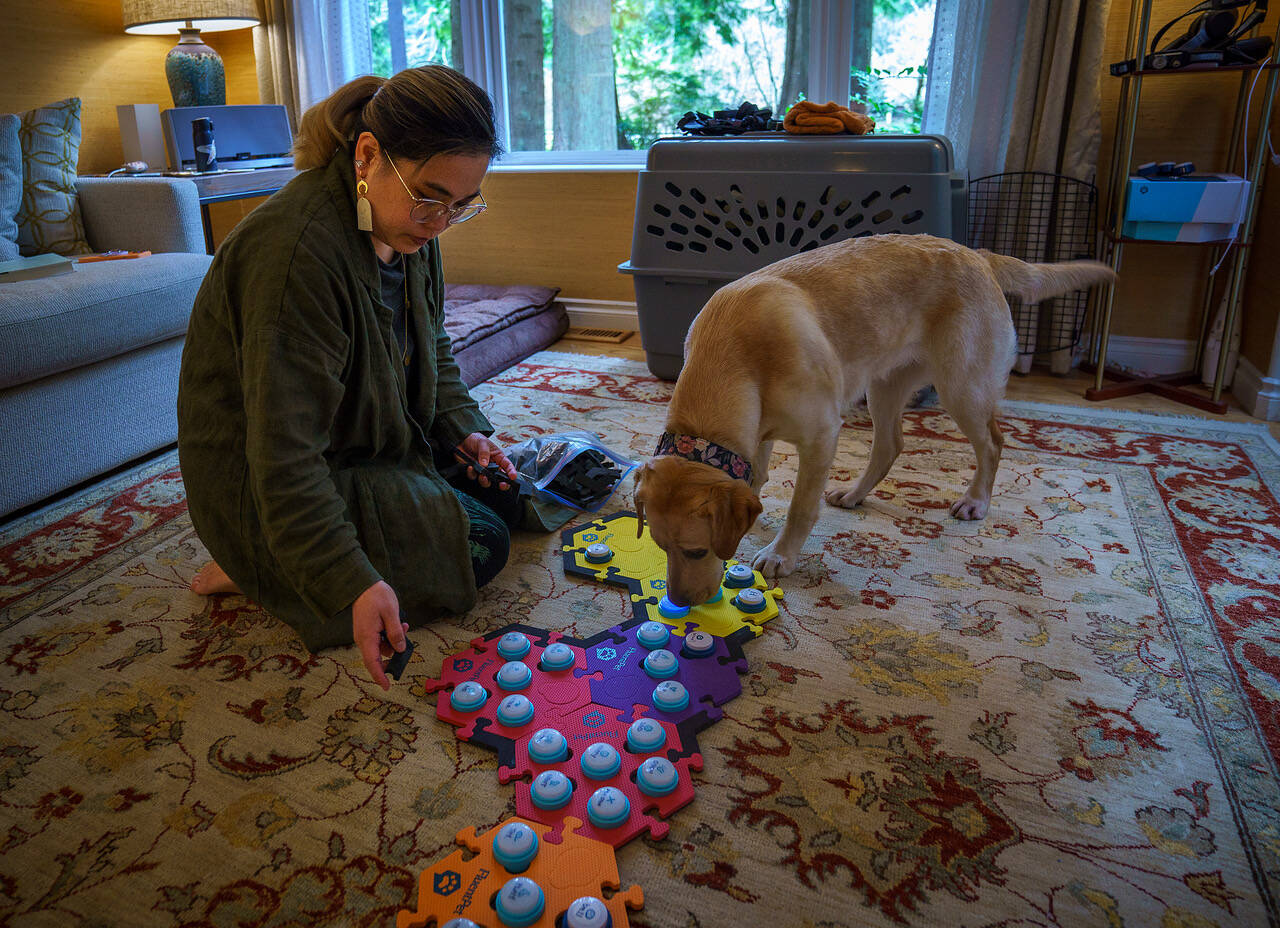Most dog owners have to guess how their pooch is feeling at any given moment. With the press of a button, yellow Labrador Poppy Seed Muffin can instantly express herself.
Poppy uses a set of paw-sized buttons to speak to Langley resident Jane Fung, her owner, and other humans who are present. The 38 different buttons, which are accompanied by a recording of Fung’s voice when pressed, help Poppy verbalize her needs, emotions and observations.
For example, the appearance of a new female visitor in the house caused Poppy to first click a button labeled “mommy” and then another one labeled “now.” Her curiosity surrounding a camera bag brought into the room resulted in her pushing the “open it” button.
Pressing buttons, Fung explained, is just as important as the sequence. She noticed this one day when Poppy decided to clue Fung in on her morning routine with Fung’s husband, who usually gets up with Poppy. She told Fung, who had gotten up with her instead that morning, that she wanted to “go potty,” “play,” and then get “water” and “food.” The next time Fung woke up with Poppy, the dog pressed those four buttons in the exact same order.
“If you don’t know the context, it just sounds like gibberish,” Fung said.
Fung has been working with Poppy on her communication skills for nearly a year, since she was a puppy. Inspired by TikTok sensation and Instagram-famous Bunny the talking dog, Fung wondered if her dog could also learn how to speak. She also read “How Stella Learned to Talk,” a 2021 memoir and how-to guide written by a speech pathologist who discovered her dog could learn the same button-pressing form of communication that she had taught impaired children how to use.
Fung uses colored sections of board and buttons from brand FluentPet. The colors are associated with different groupings of buttons, from needs to actions to places. She started simple with just a few buttons, like “play,” “water” and “outside.”
“You’re actually teaching them,” she said. “A lot of it is through modeling the behavior or modeling the situation. Every time we went outside, we would click the outside button first, and she’d understand.”
During her adolescence, Poppy has been less than truthful about a few things, especially when it comes to wanting to go outside when she doesn’t have any business to do.
“She’s definitely in the teenager stage,” Fung said. “She doesn’t lie as much anymore, but she used to, when she was about 9 months old.”
Though Fung expected Poppy to ask for food and snacks all the time, those are buttons she rarely presses. Fung thinks it’s a good sign that her needs are being met. Lately, Poppy’s been clicking the “deer” button a lot, not necessarily because she sees the animals, but as a reference to the outside world and the front yard of the house she’d like to explore.
Poppy also uses the buttons to convey emotions, usually when she is feeling either happy or left out.
“We were hoping she’d use it for physical pain, but she’s really used ‘ouch’ more when she has hurt feelings,” Fung said, adding that Poppy will try to get her attention if she feels ignored while Fung is working.
In addition to the buttons, Fung is training Poppy to be her service dog. The “school” button indicates that she is ready to complete some of this training. She knows over 30 verbal commands.
“She is my very first dog,” Fung said. “I’ve waited my whole life for her.”
Poppy has continued to blow her mind with some of the things she’s said.
“I’m pretty sure that she’s told me about her dreams before,” Fung said. “One day I just let her out of the crate and right away she looked up at me and blinked her sleepy eyes and said, ‘School, all done,’ like she was dreaming about school.”
Added just last week, one of Poppy’s newest words is “beach.” Living on Whidbey Island, she’s very familiar with the place. Fung keeps a growing list of words that will eventually be added to the button board.
“I think that dogs really enjoy mental stimulation as much as physical stimulation,” Fung said. “I want her to be able to live a really full life, and that includes mental, physical stimulation but also being able to advocate for herself and be able to ask for the things she needs or wants.”
Since teaching Poppy how to use language, Fung has noticed that the dog likes to be told when things are happening so she doesn’t feel anxious about the day. She wants to be warned before the vacuum cleaner is turned on, for example, or when she is going to be left alone for the day.
Poppy’s adventures can be followed on Instagram @poppyseed_tales.
“It’s just so heartwarming when she has things to tell you sometimes,” Fung said.



